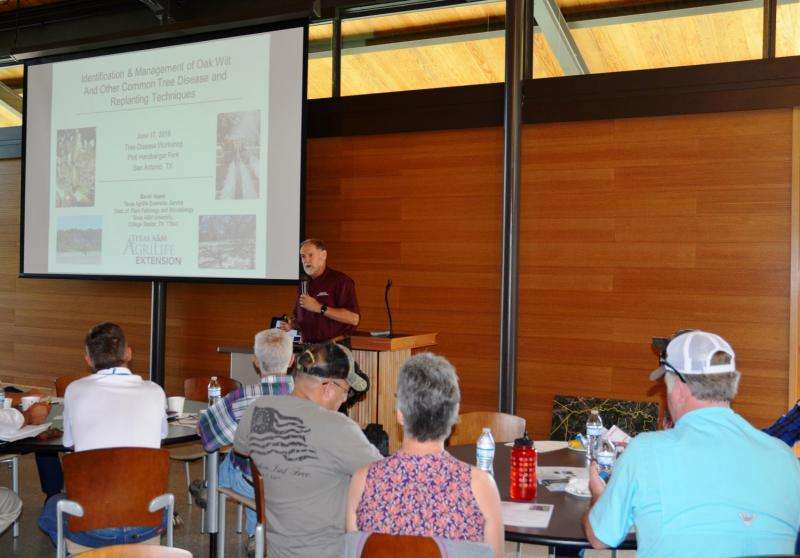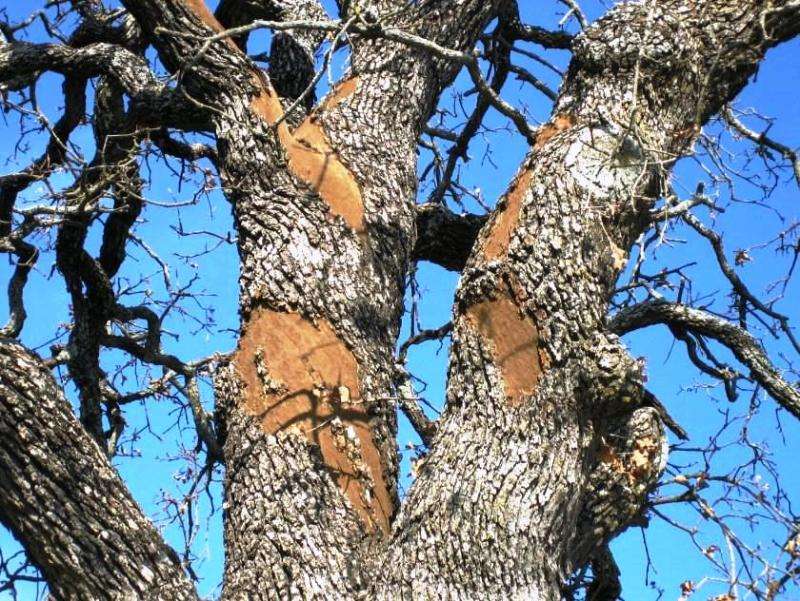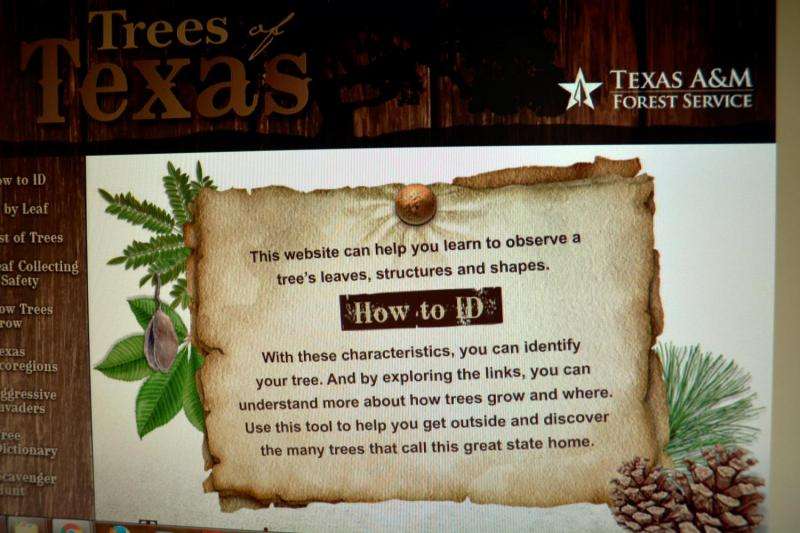Oak wilt, other tree diseases examined at program in San Antonio

Tree diseases, with oak wilt taking center stage, were the focus of the Tree Disease Identification and Management program held recently at the Urban Ecology Center at Phil Hardberger Park in San Antonio.
More than 120 people, including landscapers, tree care experts, certified arborists, green industry representatives, Master Gardeners and Master Naturalists, attended the program, presented by the Texas A&M AgriLife Extension Service, Texas A&M Forest Service and City of San Antonio.
"This purpose of this program was to provide information and practical demonstrations relating to plant diseases, and how to help prevent and/or manage them if they occur," said David Rodriguez, AgriLife Extension horticulturist, Bexar County.
Program presentations addressed identification and management of oak wilt and other common tree diseases, city tree maintenance requirements, tips to minimize plant stress, proper pruning techniques, replanting techniques and managing tree insects.
At the start of the program, a demonstration on air excavation and tree injection was given by Bartlett Tree Experts of San Antonio.
"Air excavation and tree injection with a fungicide are methods of treating oak wilt," said John Worrell, local manager for Bartlett. "There's no cure for oak wilt, but there are ways to treat it and spare the tree from further damage. You can use injection in combination with trenching, which segregates the tree roots and makes sort of a fire line to keep it from spreading."
Worrell also said with the recent rainfall the vascular activity of oak trees has increased, which may lead to an increase in oak wilt due to the fungus which causes it being a vascular parasite.
Dr. David Appel, Texas A&M AgriLife Research plant pathologist, College Station, was the program's key speaker.
Appel explained how oak wilt is caused by a fungus and is spread by contaminated nitidulid beetles that bring it into fresh wounds on oak trees. He said while the fungus associated with oak wilt, ceratocystis fagacearum, will "always be a part of the Central Texas landscape," it is heat sensitive and its spores are not airborne, so "several specific factors are needed for its transmission."
Appel also described and addressed other tree diseases, including hypoxylon cankers, root rots, bacterial leaf scorch and native elm wilt.
"Right now, one of the things people need to do is remember to be cautious about transporting oak wilt via infected firewood from the Hill Country," he said. "If you find oak wilt on your property, you can keep it from spreading to a non-infected tree through connected roots by trenching. And you can inject fungicide into the affected tree. Together, these, make an effective package for preventing the spread of oak wilt."
Appel also suggested the Texas A&M Forest Service website at texastreeid.tamu.edu/ and Texas Plant Disease Diagnostic Lab site at plantclinic.tamu.edu as good sources for additional information on oak wilt and other diseases.

Molly Keck, AgriLife Extension entomologist for Bexar County, told attendees about a dozen or so insects that can manage tree pests and how an integrated pest management approach can help deal with them.
"The insect pests of greatest concern to homeowners are usually the insects that bore into trees," she said. "Often they feel these borers are the primary cause for sick or dying trees. However, these insects are just attracted to trees that are already sick or badly stressed, such as trees that have been exposed to drought conditions."
Mark Duff, a forester with the Texas A&M Forest Service based in San Antonio, told attendees about proper pruning techniques and how to reduce tree stress factors.
"It's extremely important that you paint all pruning cuts made to oaks," he said. "You also want to avoid topping trees, which means cutting off too much of the tree canopy, and to avoid lions-tailing or stripping out interior branches. And you shouldn't remove more than one-third of a tree's foliage."
Mark Bird, an arborist with the City of San Antonio told attendees about the city's oak wilt ordinance and discussed license requirements and diversity in tree replacement and landscape planning.
"The city has an oak wilt requirement that if you trim or prune an oak tree you must paint the exposed area within 30 minutes," he said. "And if you are tree maintenance person wanting to work for the city, you need to receive training for a license that's issued by the city, plus have liability insurance."

Leticia Zavala of San Antonio, president of C-F-Z Group LLC and a landscape designer for more than 30 years, was one of the program attendees.
"I came to the program to educate myself on oak wilt and other tree diseases," Zavala said. "Knowing about these trees is important in meeting the city's tree preservation requirements. It's also good for determining the types or diversity of trees to use in designing a landscape."
Dwayne Robinson, constituent service director from the office of Bexar County Judge Nelson Wolff, also attended the program to get what he called "some insights on how we can do a better job of working with the issue of oak wilt in a more collective way."
"Bexar County consists of San Antonio and 26 other cities, and oak wilt is a countywide issue that we need to address with a sense of urgency," Robinson said. "From what I've seen in this program, I'm optimistic about what can be done to treat this disease."
Robinson said some ways the county might work toward addressing the issue include working with developers to educate people in new developments about oak wilt and how to address it, collaborating with CPS Energy on tree giveaways and making sure tree maintenance professionals trim oaks at the appropriate time to minimize the risk of spreading the disease.
Mark Kroeze, a staff forester with the Texas A&M Forest Service who assisted with the program, said he hoped those attending would leave with better observation skills with which to identify tree disease, as well as a better understanding of how those diseases are transmitted.
"It's also important they take away the fact that trees, like people, get diseases and can be successfully treated for them," he said.
Provided by Texas A&M University


















